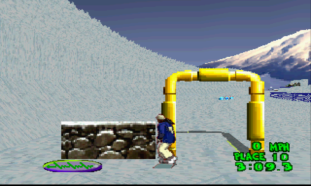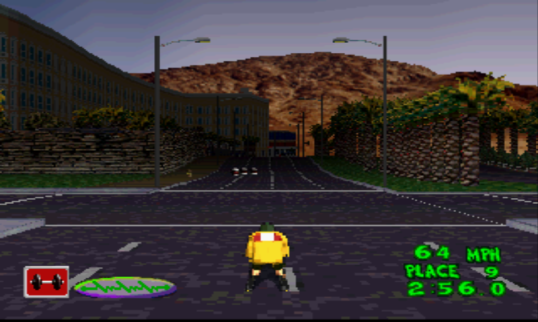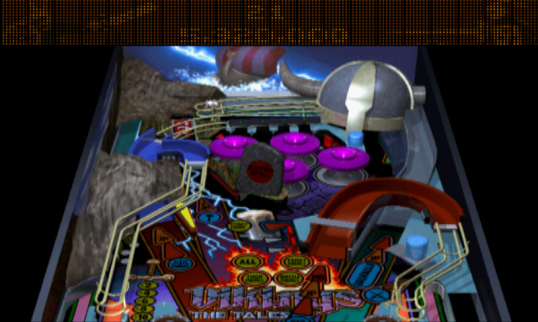Today in 32 Bits: I play a game so screamingly 90s that even its menu screens are extreme; a sequel to a Playstation launch title, it proved the last success in a short-lived franchise. Also, pinball.
32 Bits is a series where I play and review the most popular games of the past – the games that sold well in their day, not what we look back on fondly now. Why were they popular, what did their success mean, and do they hold up today? Some are loved, others loathed, and many more forgotten.
Information on what games will be reviewed can be found here; my reviews of 1995′s games are archived on this page, while links to reviews from the current season – and a list of those to come – can be found here.
New posts are made every Sunday, while Sega Saturn reviews are posted on some Saturdays.
2Xtreme
| Developer | Publisher | Release Date | Best-Seller in | Playstation Review Number |
|---|---|---|---|---|
| Sony Interactive Studios America | SCEA | 10/31/96 (North America) 4/11/97 (Japan) 3/6/97 (Europe) |
North America (Greatest Hits) | #43 |
Previously: I played ESPN Extreme Games, a Playstation launch title that tried to give an extreme sports veneer to the Road Rash formula. I didn’t like it.
2Xtreme is undoubtedly the most 90’s video game name ever conceived, a name that makes one run to the nearest source of Mountain Dew and Doritos. And the game is extreme. It’s extremely lazy, extremely poor, and you could make an extremely good case it killed off its series – despite its success. But more on that later.
2Xtreme begins with the typical mid-90s EXTREME TO THE MAX intro where athletes jump, ski and do tricks over a computer-generated mountain. Hilariously, even the game’s menu is extreme: not only is every option accompanied with a blaring explosion noise, each choice brings on a short, first-person cinematic of a skateboarder going down a half-pipe. At the end? You jump up to the other menu you chose. Amazing. Watch it above.
ESPN Extreme Games, this game’s predecessor (renamed 1Xtreme when it came out as one of Sony’s Greatest Hits) posited the existence of a race that sent skateboarders, mountain bikers, rollerbladers and street lugers careening through jungle temples and city streets. The shoulder buttons allowed the player to punch and kick their fellow racers. If the tracks didn’t go on forever, it might have made for some quick, zany fun. Unfortunately, it was just tedious.
2Xtreme plays similarly to the original: you race down courses, you go through gates to get money and power-ups (I honestly can’t remember if these were in the original).
But street luge’s out and snowboarding is in (and get used to snowboarding, folks, because I have Cool Boarders coming up at the end of the season and I don’t doubt that eventually every other game I review will feature snowboarding). Each race only allows for one type of vehicle: Japan for snowboarding, LA for skateboarding, Las Vegas for rollerblading and “Africa” for mountain bikes. The four vehicles mean four courses – less than the original – but each has three stages.
Los Angeles: a city strewn with barrels in the street. You play this stage on skateboards. Features a night stage that’s, amazingly, just the same level but dark. No streetlights or anything…even though, you know, they’re right there.
Las Vegas: rollerblade down the strip – or a generic city with occasional casinos you see in passing. Casinos with a suspicious lack of neon.
Africa: Where in Africa? The place with elephants, zebras, huts in the middle of the street, and that one tree that’s on the cover of every book set in Africa, of course. Probably the most fun track – to look at, not to play. Just like the South American track in 1Xtreme, jungles resemble every other indoor area, painted green.
Japan: A snowboarding track in Japan. Lots of snow.
Nothing else is different: the game still plays the same in every respect except, hey, you have snowboards now. You still pass through gates. You still face a large pack of racers – though I believe it’s less than the original.
 Courses wind on and are largely identical in terms of actual challenges; the 2D sprites used for the characters are still jerky and indistinguishable from one another; the Road Rash-esque mechanics just don’t fit, and the “XTREME” trapping make navigating the game’s menus an incredibly tedious experience.
Courses wind on and are largely identical in terms of actual challenges; the 2D sprites used for the characters are still jerky and indistinguishable from one another; the Road Rash-esque mechanics just don’t fit, and the “XTREME” trapping make navigating the game’s menus an incredibly tedious experience.
I didn’t think it could be possible, but 2Xtreme is somehow worse than the original, and the original was awful. The mind-numbing extreme elements, the lack of content, the graphics (which aren’t just bad by modern standards like most Playstation games, but bad by the standards of the 1996), the lack of any change…
The top-selling Playstation games of all time allegedly include Gran Turismo (10 million copies), Final Fantasy VII (9), Gran Turismo 2 (9), Tekken 3 (8.5) and Final Fantasy VIII (8). On the list from 1996: of games I’ve played already, Crash Bandicoot (6.8), Resident Evil (5), Tekken 2 (3), Mortal Kombat Trilogy (2). Games I’ll play soon: Tomb Raider (7), Twisted Metal 2 (1.7), Jet Moto (1.2).
And 2Xtreme sold over a million copies.
I can almost understand why. 2Xtreme’s extreme! Arguably extreme to the max. And people enjoyed the first game. But just like Battle Arena Toshinden, people would reject the game’s third installment. After all, the standards for a launch title are lower and many
1999’s 3Xtreme reinvented itself as a fully 3D game, but kept the same gameplay. Letting the series lay dormant for three years probably wasn’t wise, since the resulting the game was hardly a masterpiece. Unlike its predecessors, I’ve played it before.
I only had a Playstation at the tail end of the system’s life. So in 1999 I popped in a demo disc. There was awkward, failing 3Xtreme. And next to it? Tony Hawk’s Pro Skater. One promised dull racing, the other speed and freedom. In 1999, this series was on the way out. The other was just about to spawn arguably the system’s greatest game.
WHO MADE IT?
In 1998 developers Sony Interactive Studios America were renamed 989 Studios, remaining Sony’s internal development division. They developed mainly sports games, but they also made games people like, such as 1997’s Rally Cross. But they also made Spawn: The Eternal, one of the system’s worst games. They also handled the post-SingleTrac Twisted Metal games – neither of which were exactly loved.
Their 1998 game Blasto was a comedic third-person action game starring Phil Hartman, and was released a short time before his death.
They’re also credited with publishing 1999’s Syphon Filter, a popular series in the Playstation’s last years, and the Cool Boarders games, as well as 1998’s animal racer Running Wild and NFL Blitz-esque NFL Xtreme (sigh).
A division of the company developing online games such as 1997’s Tanarus was spun-off into a new division that developed EverQuest, one of the first big MMOs. Now named Sony Online Entertainment, they continue to develop games like Planetside 2.
TRUE PINBALL
| Developer | Publisher | Release Date | Best-Seller in | Also On | Playstation Review Number |
|---|---|---|---|---|---|
| Digital Illusions | Acclaim | May 96 (Europe) 5/31/96 (Japan) September 96 (NA) |
Europe (Platinum) | Saturn | #44 |
There’s something ghoulish about playing a pinball video game. You’re experiencing pinball on the platform that killed it. Walls of video games crowded pinball machines out of arcades in the ‘70s.
The decline of pinball wasn’t due to creative sloth. Pinball designers responded to video games by merging the two forms. Pinball machines gained voices, LED screens, and new mechanics. This wild innovation sparked a brief pinball resurgence in the 1990s – ironically as arcade video games were themselves dying.
True Pinball’s surprisingly slick presentation offers up several different pinball tables, all emphasizing the kind of multimedia gimmicks you’d find in a contemporaneous pinball game. On the Viking table a fight begun on the screen above the table between two knights; I don’t quite know what happened, but I did acquire a grail, so there’s that.
The square button controls the right flipper, while the left arrow controls the left. Tilting is accomplished by the X button, R1 and L1. It’s an interesting layout since it spaces out the movements in a way that largely makes sense.
I need to confess: I’ve never even played a pinball machine. Except maybe one in the corner of a movie theater. The arcade age passed me by. I discovered them now and then: in a bowling alley, or scattered across hotels in a chintzy vacation town (my favorite: a hotel with a single Crazy Taxi machine in a random hallway). You find a good one occasionally, but it’s fleeting: most will be gone the next year.
In 1996, you’d have been better off playing a real pinball table – if you could find one.
![]()
______________________________________________________________________
Next Time: I try to dethrone the 95-96 Bulls with an unlikely team in a review of the Saturn’s NBA Action; I look at Tokyo Highway Battle and Formula 1.

















You must be logged in to post a comment.